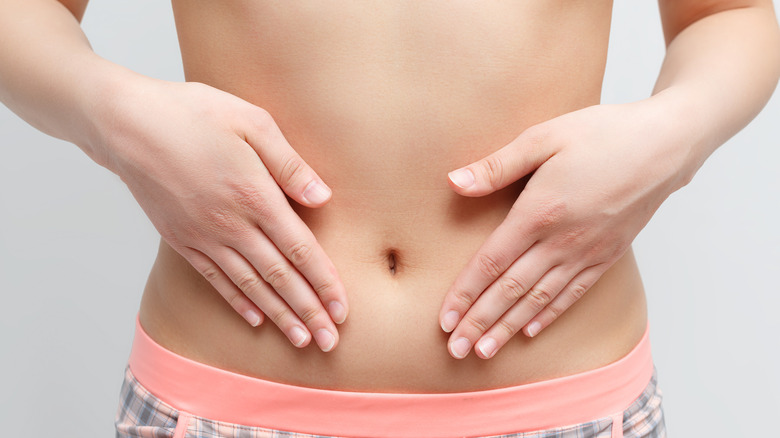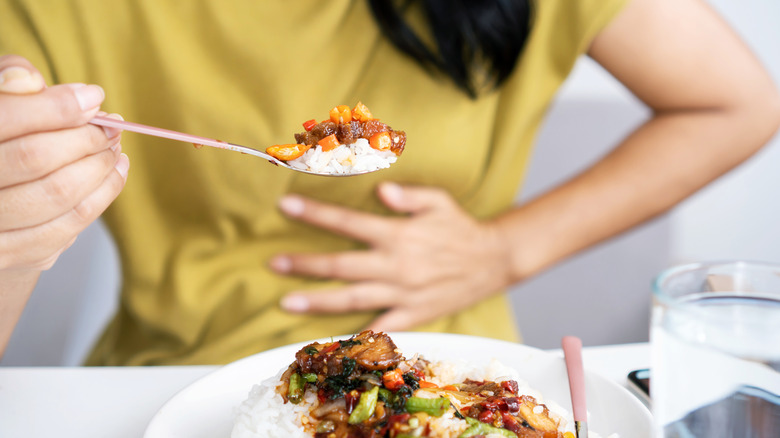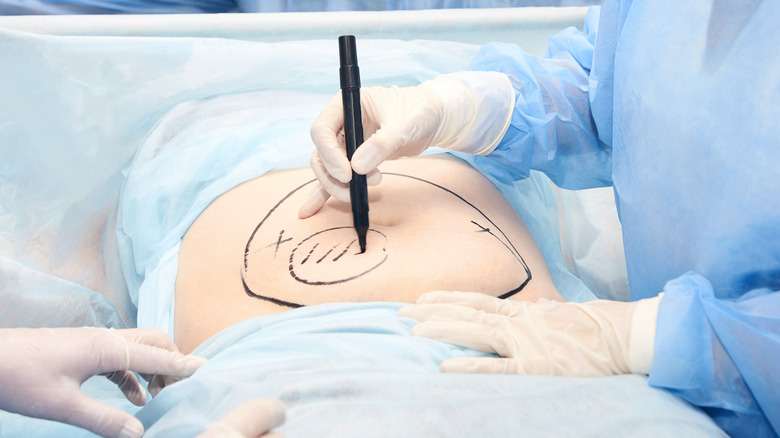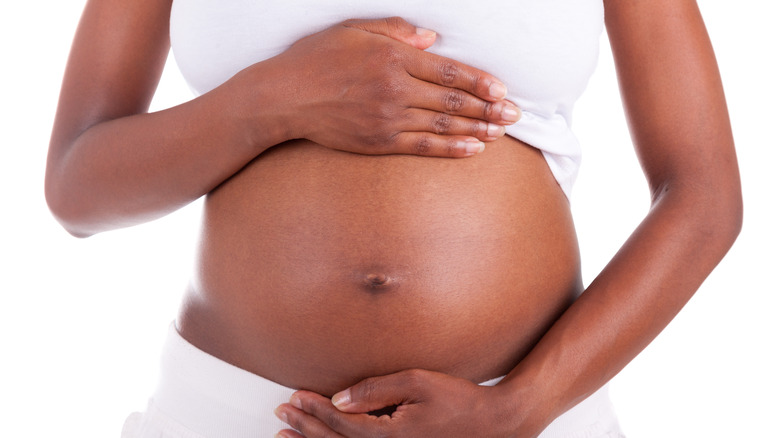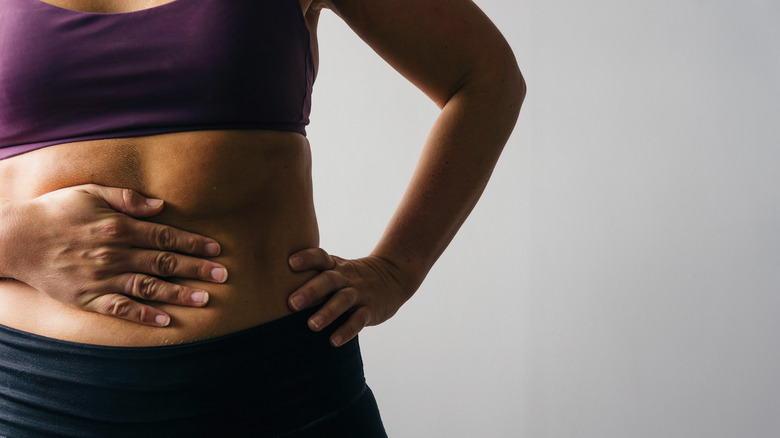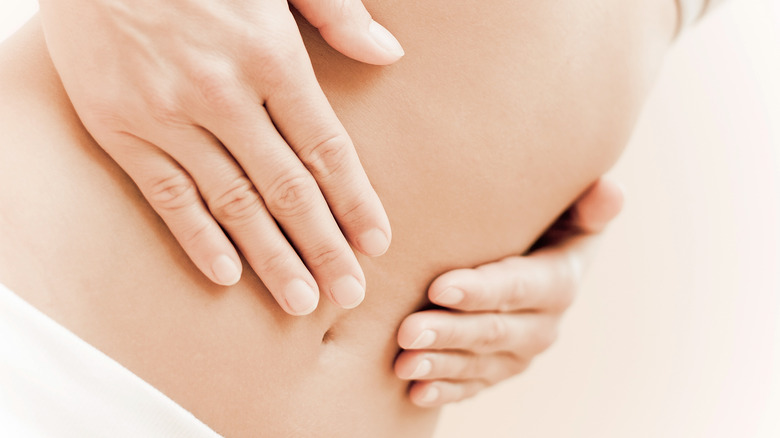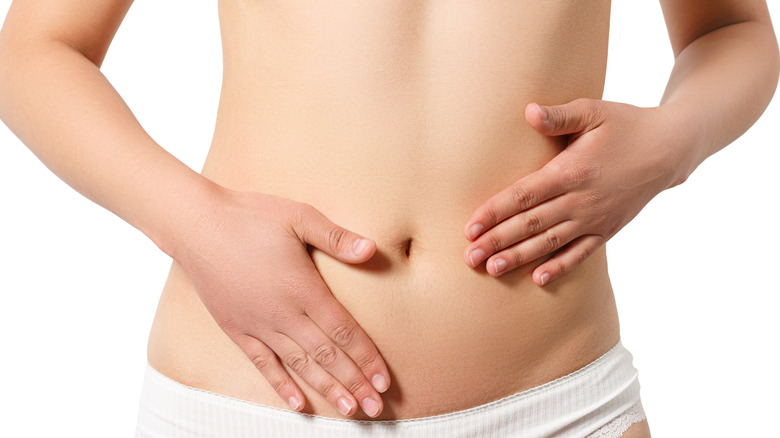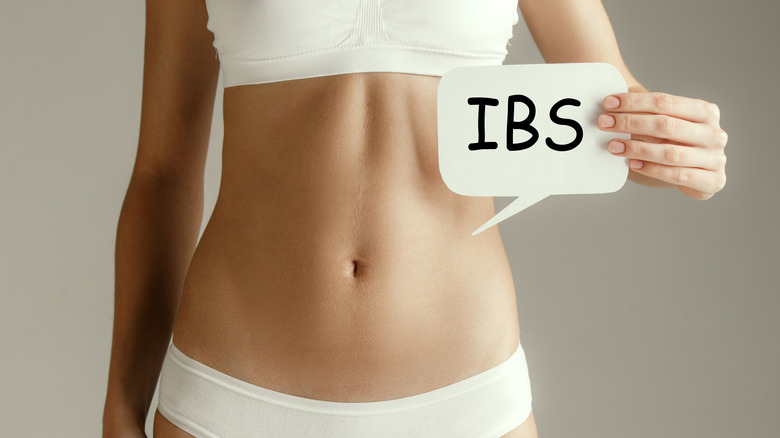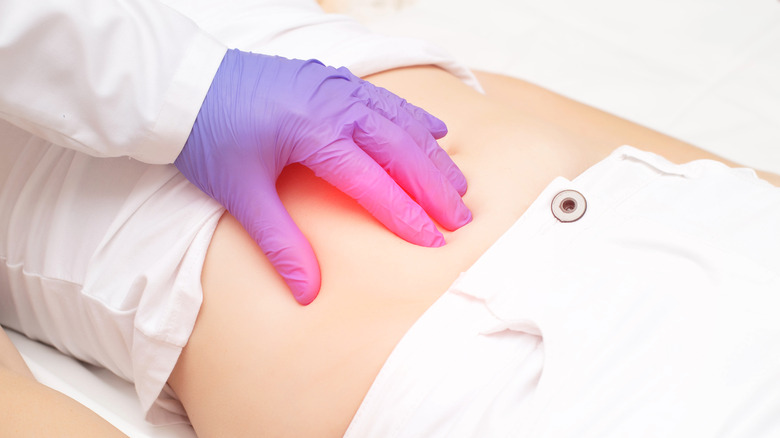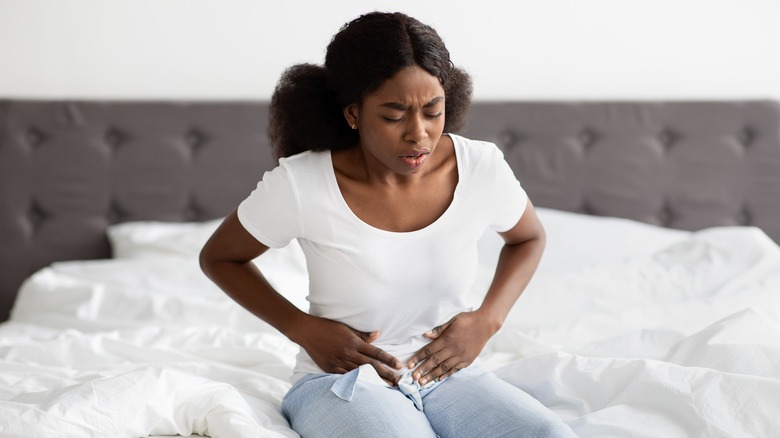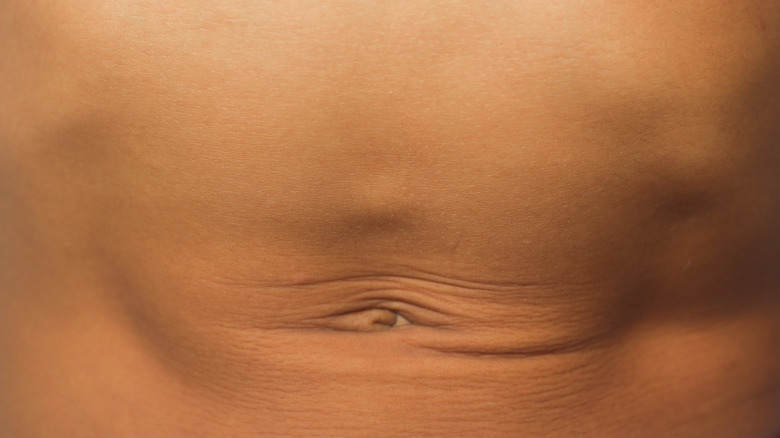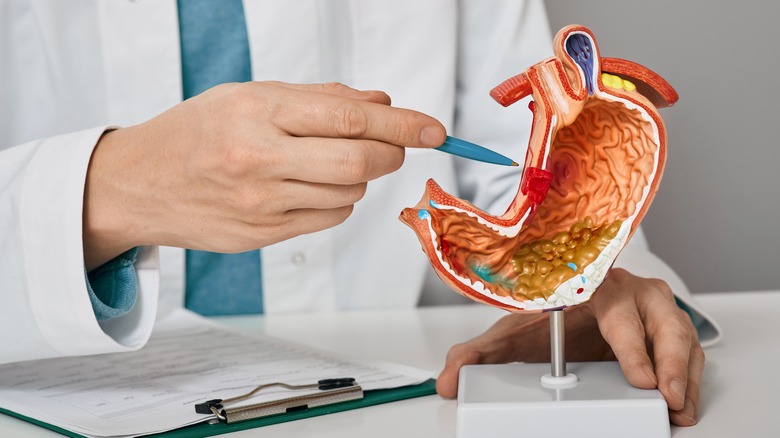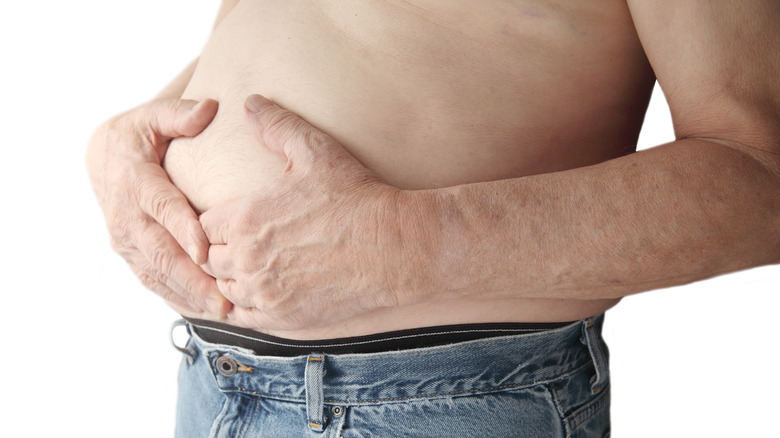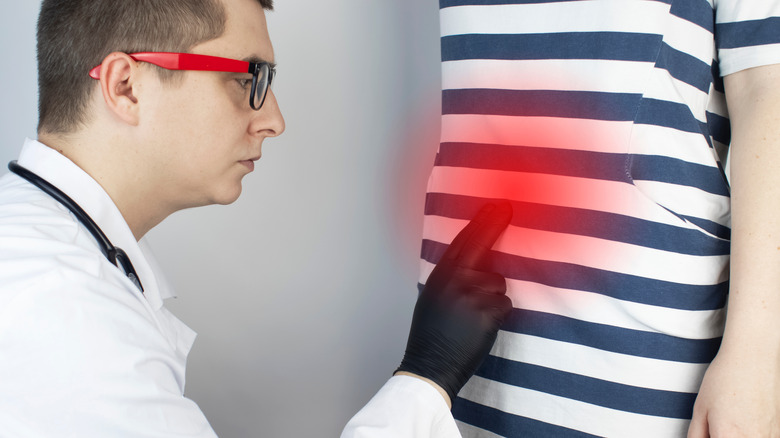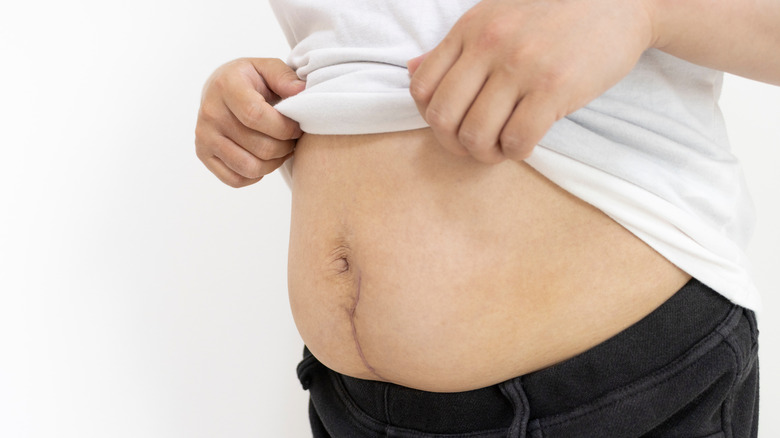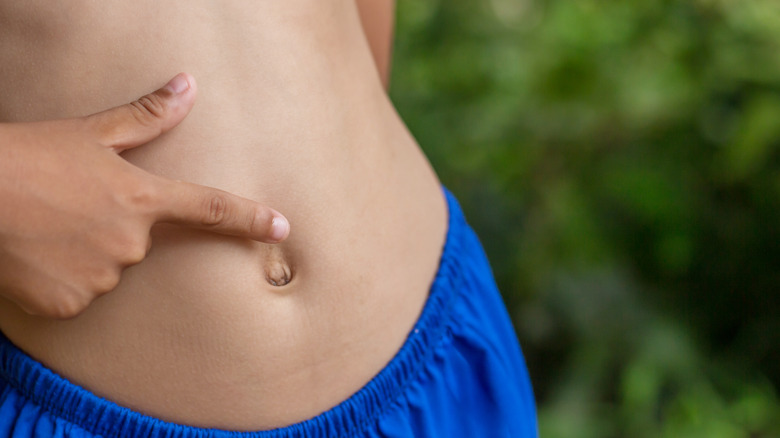What It Means When Your Belly Button Hurts
Most people don't spend much time thinking about their belly buttons. It's not typically a part of the body that many concern themselves with until pain sets in. Pain that occurs in, near, or around the belly button can materialize in different forms — from quick, sharp sensations to persistent aches that come about slowly. It's also possible for the discomfort to come and go and be accompanied by other symptoms like nausea or vomiting.
When the pain sets in, it can feel like it's coming directly from the navel area, or it could radiate from different abdomen regions. Belly button pain (also known as periumbilical pain) isn't an ailment of its own; rather, there is a laundry list of reasons you could be experiencing discomfort in this region of your body. Some causes are common whereas others are rare (via Medical News Today). Be sure to consult your doctor if you're experiencing periumbilical pain.
Indigestion
If you feel pain in your belly button area during a meal or after you have finished eating, you may be experiencing indigestion. As family physician Sandria T. Vernon told Riverside Commonwealth Family Medicine, "About one of every four people will have [indigestion] at some point." This can happen regardless of age, and it may be regular or occasional.
To prevent the onset of indigestion, avoid eating fatty foods and limit the amount of alcohol and caffeinated drinks you consume. If you're typically a fast eater, try to slow down, and also avoid overeating (via MedlinePlus) Don't exercise right after you finish eating, and chew your food completely so it can be properly digested.
You may be tempted to take aspirin or ibuprofen to relieve your belly button pain, but if indigestion is the cause, this can make matters worse. At the very least, you should take NSAIDs on a full stomach.
Recent abdominal surgery
You may experience pain in or around your belly button area after having abdominal surgery, such as a hernia repair, appendectomy (removal of the appendix), or hysterectomy (removal of the uterus), according to Verywell Health. Belly button aches are not uncommon for those who have had laparoscopic surgery because, during this operation, the doctor will cut or make a slit in the area of the belly that sits right below the belly button.
Memorial Sloan Kettering Cancer Center suggests managing pain following abdominal llaparoscopic surgery with pain medication prescribed by your physician as well as applying heat. Additionally, you should try to walk around within a few hours after surgery. While at home recovering, continue waking every couple of hours or so. The pain in and around the belly button should not last more than several days following this type of surgery; however, if the pain persists, you should contact your doctor (via MyHealth.Alberta.ca).
Pregnancy
Belly button pain doesn't happen to every pregnant person. Still, as your tummy grows and stretches during these months, you might experience some discomfort. If your navel is in an "innie" during the stages of bringing life into the world, your belly button may start protruding, which can cause friction as your clothes rub against that part of your skin. A maternity tummy sleeve or maternity shaper is a great way to mitigate friction (via What to Expect).
A belly button piercing could also cause pain, as your stomach is stretching during pregnancy. Some choose to take it out during pregnancy, while others opt to keep it in. Professional piercer Adrian Castillo has some advice if you choose to keep wearing your piercing during pregnancy. "There's definitely jewelry that I'd recommend pregnant women staying away from," he told Allure. "You'd want to avoid most metal-based jewelry for sure, like steel, titanium, and gold, even. There's no flexibility with metals." Jewelry made of polytetrafluoroethylene (PTFE) is a much better option for those wanting to sport their belly button piercing while pregnant (via Healthline).
Bowel obstruction or constipation
According to the National Library of Medicine, bowel obstruction (also known as an intestinal obstruction) happens when your food or stool isn't able to move within your intestines. When your digestive system isn't functioning normally, one of the symptoms you most likely feel is pain in the area surrounding your belly button. One of the other symptoms you could be having is constipation. A bowel obstruction is more likely if you're experiencing nausea or vomiting alongside belly button aches. While constipation can be an ongoing problem, bowel obstruction is very different. As Dr. Richard A. Desi, a gastroenterologist at Mercy Medical Center in Baltimore, explained to Everyday Health, "Bowel obstruction is nothing chronic — there's usually a very dramatic progression of symptoms." This condition requires immediate attention.
If you have belly button pain with abnormal bowel movements and hard stools, chances are you're constipated (via John Hopkins Medicine). Constipation is a relatively common condition (4 million people experience it frequently). To avoid or relieve constipation, add fluids and fiber to your diet and pay attention to your bowel habits if you aren't doing so already. Consult your doctor if your constipation lasts for over three weeks.
Urinary tract infection (UTI)
While pain below the belly button isn't the most common symptom of a urinary tract infection (UTI), it's still a symptom to watch for. Other symptoms include a burning sensation when urinating and discoloration in your urine (via Cedars Sinai). You may also feel like you have to pee but are unable to, and you may even develop a fever.
As Medical News Today advises, you should see your doctor if the pain in your abdomen area or the discomfort you experience while urinating continues for more than a couple of days. There are a few ways to combat a urinary tract infection — but prevention is the best path to take. Staying hydrated by drinking plenty of fluids, especially water, and wiping from front to back after urinating are the top two preventative measures you can take to prevent the spread of bacteria, which causes UTIs (via Healthline).
Gallstones
When small, hard deposits usually made of cholesterol build up in your gallbladder (an organ located under your liver), gallstones occur (per Mayo Clinic). Approximately 10 to 15% of Americans get gallstones, according to the National Institute of Diabetes and Digestive and Kidney Diseases. Unfortunately, a whopping 80% of people who have gallstones don't even know because they aren't experiencing any symptoms. This is called "silent gallstones."
Gallstones can lead to acute cholecystitis, or galldbladder inflammation. This can cause extreme pain above the belly button and may spread to your chest, back, and even the area between your shoulders (via NHS). Eating fatty foods can initiate the upper abdomen aches associated with gallstones, lasting anywhere from one to a couple of hours. If the pain doesn't diminish in a few hours or if the pain is accompanied by fever, nausea, or vomiting, it's important to see a physician immediately. Other warning signs include brownish-looking urine, stool that is light in color, and a yellowing of your skin and eyes (via Highland Medical, P.C.).
Irritable bowel syndrome (IBS)
The pain you're feeling around the area of your belly button could be because you're suffering from a relatively common syndrome, which approximately 20% of Americans have. The condition is called irritable bowel syndrome, better known as IBS (via University of Michigan Health). "IBS is a gastrointestinal (GI) condition that causes recurrent attacks of abdominal pain or discomfort in association with bowel habits," according to the International Foundation for Gastrointestinal Disorders.
Dr. Priyam V. Tripathi, a gastroenterologist at the UCLA David Geffen School of Medicine, told Self, "With IBS, the abdominal cramping is usually in the lower abdomen ... and often improves after completing bowel movements." However, the cramping sensation you're feeling below your navel area is only one of the symptoms. Others include stomach pain, bloating, and in some instances, nausea, according to the Cleveland Clinic.
You're going to want to see a doctor if you start experiencing more severe symptoms such as bleeding from your rectum, weight loss, trouble with swallowing, or continuous pain that won't go away by passing gas or going to the bathroom. While there's no cure for IBS, rest assured the symptoms can be controlled, often through diet and lifestyle changes (via Mayo Clinic).
Appendicitis
According to the National Institute of Diabetes and Digestive and Kidney Diseases, 5 to 9% of people living in the United States will be affected by appendicitis at some point in their lives. Appendicitis occurs when the lining of your appendix (a small pouch attached to the large intestine) becomes blocked. This can result in infection.
Appendicitis is mainly seen in young people between 10 and 30 years old, and one of the most prevalent symptoms is pain in your stomach (via John Hopkins Medicine). Dr. Cedrek McFadden, a board-certified gastrointestinal surgeon, told The Healthy, "The pain is generally located around the umbilicus, aka the belly button, and in about 50 percent of patients, the pain migrates to the right lower quadrant of the abdomen." Over time, this pain will become more severe.
If the pain around the area around your belly button starts to become excruciating or you're experiencing other symptoms, such as vomiting or nausea, fever, chills, diarrhea, difficulty moving, or gas, it's vital to get to the hospital right away.
Fungal or bacterial skin infection
Yeast, a fungus that occurs effortlessly and naturally on the skin, can thrive in your navel. According to the Cleveland Clinic, you may be more prone to get fungal infections if you wear clothes that are too tight, practice poor hygiene, or if the weather is hot and muggy. However, fungus isn't the only thing that grows easily in moist, dark places like your belly button. Bacteria also thrive there. In fact, one study found that 67 different types of bacteria can be found in the navel.
Bacterial infections are typically accompanied by pain, swelling, scabbing, and yellowish or greenish discharge. Fungal infections, on the other hand, tend to itch and may cause a white discharge from the belly button area. Whatever uncomfortable symptoms you're experiencing in or around your belly button, it's imperative that you see a doctor so you can adequately be diagnosed and treated.
A stomach infection
Are you having pains in or around your belly button area and experiencing symptoms such as diarrhea or vomiting? You could potentially have a stomach infection, which could be viral, bacterial, or parasitic, according to Medical News Today. Drinking water or food that has been contaminated can lead to such infections. You can also be stricken with a parasitic infection if you have swam in waters that have been polluted.
In addition to having pain around your navel, you may experience gassiness, bloating, muscle aches, weight loss, fever, and loss of appetite. While treatment from a doctor is not always needed to recover from a viral or bacterial stomach infection, it's a good idea to see a medical professional if your pain becomes severe and your diarrhea lasts for more than two days, or if you're feeling dehydrated. Plus, if you think you have a parasitic infection, medication is necessary to get well.
A hernia
A dull achy pain in your belly button and swelling and bulging near the naval, may mean that you may have a hernia — specifically an umbilical hernia (via Loyola Medicine). Dr. Troy E. Madsen, a tenured associate professor in the department of emergency medicine at the University of Utah and an ER physician, told the University of Utah Health Sciences that a hernia is "a tear in the lining of the abdomen."
While an umbilical hernia is pretty common in infants, adults can also develop one. An umbilical hernia occurs when part of your intestine bulges through the gap in your ab muscles near your belly button. A hernia can result when too much pressure is applied to a weak section of the abdominal muscles. Straining to lift or pick up heavy objects, having obesity, giving birth, and even having a persistent cough can cause a person to develop an umbilical hernia, according to John Hopkins Medicine. In children, umbilical hernias often go away on their own. In adults, surgery may be recommended.
An ulcer
Are you experiencing either a burning pain or a dull sensation between your belly button and your breastbone? Are you feeling this gnawing sensation around the time you eat or in the middle of the night? You could be experiencing this discomfort due to an ulcer.
"A stomach ulcer occurs when gastric acid eats away at your protective stomach lining," according to the Cleveland Clinic. A few other primary symptoms to look for are chest or back pain, unintended weight loss, bloody stools, and bloating, to name a few. Dr. Shipla Ravella, a gastroenterologist at New York-Presbyterian and Columbia University Medical Center, told Women's Health "The two main causes of ulcers in the U.S. are a bacterial infection called H. pylori, and long-term use of aspirin and NSAID painkillers (ibuprofen and naproxen)." While an ulcer may sound terrifying, it's worth remembering that it is both common and treatable.
Pancreatitis
We are not trying to scare you, but one of the key symptoms of pancreatitis is extreme pain that begins right above your belly button and spreads to your back or chest. According to the University of Minnesota's Department, "Pancreatitis is an extremely painful inflammation of the pancreas that affects about 80,000 people in the United States each year."
There are two types of pancreatitis: acute and chronic. Acute pancreatitis will almost certainly heal with treatment, but chronic pancreatitis will last and may worsen. Your pancreas can become inflamed for various reasons, but excessive drinking or having gallstones are common causes. Along with the severe pain above your navel, you may feel a few other symptoms such as nausea, fast heart rate, and sensitivity or soreness in your upper abdomen area, to name a few. The best ways to prevent pancreatitis are to live a healthy lifestyle and maintain your weight by exercising consistently. You should avoid partaking in fad diets and quit smoking if you currently smoke (via Everyday Health).
Diverticulitis
According to Healthily, a person with diverticulitis may regularly feel pain below their belly button, and the aches will travel to the left side of their stomach. One in four people who develop the disease will feel this sort of pain. In an article for Top Doctors, Dr. Giovanni D. Tebala, an upper GI & laparoscopic surgeon based in London, explained, "Patients with sudden onset of diffuse abdominal stabbing pain must seek immediate medical help."
Other symptoms associated with the disease are constipation, bloating, and irregular bowel movements — symptoms very similar to irritable bowel syndrome (IBS). While there is no definitive cause of diverticulitis, maintaining a healthy diet, exercising, eating more fiber, and drinking plenty of water can help combat the disease (via Cleveland Clinic). In the past, doctors often advised patients with diverticulitis to avoid eating popcorn, seeds, and nuts, but, as the Cleveland Clinic explained, "newer research shows that these foods do not appear to cause flare-ups."
Crohn's disease
Among the reasons you could be experiencing belly button pain is Crohn's disease. One of the more prevalent symptoms of the disease is discomfort behind your belly button, which can feel like a dull pain to a sharp excruciating cramping pain. It usually occurs one to two hours after consuming a meal (via Colon & Rectal Surgical Specialists of New York).
Dr. Bill Faubion, a gastroenterologist at Mayo Clinic, explained in a video for the Mayo Clinic that Crohn's disease is "an inflammatory bowel disease that causes chronic inflammation of the GI tract." In his video, Dr. Faubion also shared that more than a half-million people in the United States live with the disease. However, pain in and around the belly button pain isn't the only symptom that points to having Crohn's disease.
According to the Mayo Clinic, some of the other common indicators are a reoccurrence of diarrhea, weight loss, and fever. Since there could be many different reasons for pain in your abdominal area, it's important to talk to your physician.
Abdominal aortic aneurysm
Has the pain you're experiencing around your belly button come on suddenly? Or is it a persisting stabbing pain, or maybe a gnawing sensation that comes and goes? Any of these symptoms can point to an abdominal aortic aneurysm (AAA). Stanford Health Care says that the aneurysm (a weak part within the artery wall) often will grow gradually without any noticeable symptoms, making it tough to detect; however, the key symptom is the discomfort in the belly area.
The pain can be so excruciating that those suffering may find it hard to stand up and may even feel a pulsating feeling in the abdomen. Also, discomfort may be felt when there is pressure, and pain can be sensed with the slightest touch (via Spine Health). If you have these symptoms, don't try to wait them out. As the Mayo Clinic advises, "If you have pain, especially if pain is sudden and severe, seek immediate medical help."
When you should see a doctor for belly button pain
There are many reasons a person can experience belly button pain. Some conditions are relatively minor, such as indigestion or constipation. However, some can be far more serious. Depending on the underlying cause of the pain, you could feel the aching in the upper or lower areas of your abdominal area and possibly beyond. If you're struggling with belly button discomfort, don't hesitate to seek medical attention.
According to the American College of Emergency Physicians, you should call your doctor if the abdominal pain you're experiencing is mild. But if you are experiencing pain that is either severe, sudden, or lasts longer than 30 minutes, you should head to the E.R.
Additionally, if your pain is accompanied by other alarming symptoms such as fever, bloody stools, vomiting, yellowing skin, or pain so severe it hurts to touch your stomach, you should seek emergency medical attention, advised the Mayo Clinic.
